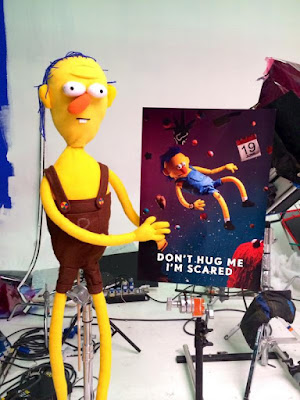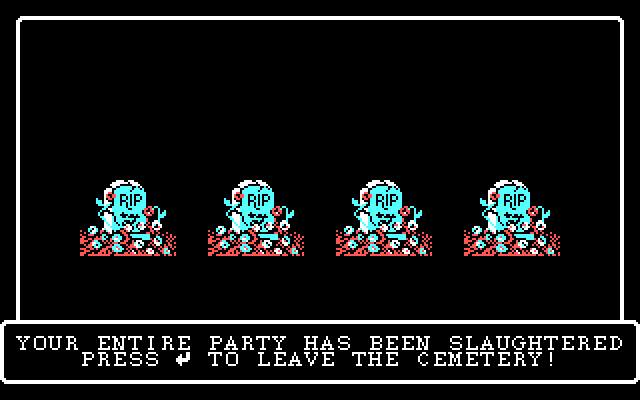 |
| Don't Hug Me I'm Scared, Post-it character ready to sing commands of mental control |
Again, I shrugged those off as I watched, taking-in the sing-song bits. Even watching them, I didn't think there was really any message, any deeper meanings except that they were fun-crazy-scary at the end.. then.. I noticed more. Some were easy to notice, such as the repetition of 19 June everywhere, both up-front and subliminally. A few more hints about the year 1955 exist as well. So what? What's the significance? I passed it off as just continuity between the far-apart releases of each episode. Oh no. No, it's far worse than that. I watched the "Kickstarter" episode as well as the last one, which is sort of "Episode 0" and, it's my opinion that be watched last for effect.
I'm familiar with a ton of internet pop-culture, from "All Your Base" and "Happy Tree Friends" and "Strong Bad / Homestar Runner" to recent releases on YouTube and I keep up-to-date with all of it as I'm a pop-culture fan, but I had only just recently heard about this. I love pop-culture and find it significant. I even absorb pop-culture significance from decades before I was born. You see, a lot of that media shapes society in ways we don't realize. Consider the 1980's: Prime-time TV and Saturday-Morning cartoons had morality messages (such as "Knowing is half-the-battle, GI Joe" and Knight Rider good-guys-finish-first credo). It shaped '80's kids to do good, try hard, etc. Video games in the '80's were tough and we were familiar with the "Game Over" screen. Yes, you would lose and that was it, no "continues" often-times. As time marched-on, the mid-'90's and later-on in video-game culture as it moved from the arcades to the bedrooms and living-rooms allowed for infinite-continues and re-spawning even later than that. I remember that phase, the removal of the "threat" of Game Over. I think it was around 1997 when I played Final Fantasy VII in Japan (when I was there) and certain mini-games allowed for infinite retries, the only consolation is "not quite as good" a reward-prize. There was really no Game Over and you could just load your game at-worst from a previous save-point if your party died. I remember that edge was lost, that fear and excitement of the danger of failing. Now there is no offer of failing. This Generation Zero never has to worry about playing a game and losing utterly, merely having instead to just re-spawn somewhere else and continue-on and fight PvP ad-infinatum. There's no negativity, just a temper-tantrum-inducing inconvenience, a mild setback at-worst. I don't play many video games anymore because of that, because of that edge lost, that simplicity of spamming a button and being rewarded for mongoloid-like behavior. I think Wizardry was the last series of games that were actually considered "difficult", which if your characters died, it would delete your save-file and you'd get a Game Over notification and, well, that was it. Done.
So what is this "Don't Hug Me I'm Scared" thing? I spent a long time (like apparently tens of millions of people have online apparently, some internet-cred I somehow missed) thinking about it. You know, it's weird I haven't heard of this until now. I shrugged it off as being just "funny-weird" but there's a hidden message and a lot of hidden things that add-up to something far more dangerous and sinister and way, WAY more deep and concerning. There's a secret message there. Can you figure it out?
Here it is at a little over 3 minutes long:
Episode 1: Let's Be Creative?
Let's start with the first episode, It's about creativity. June 19th is on the calendar. At this point we're not too sure what that might mean and it seems irrelevant. It starts with a subliminal message of a "party" theme. There's a first-shot of an air-mail theme with no postage or address. This represents a desire for freedom with no destination in-mind or a need to escape. This is relevant from Episode 0. A newspaper shows right-wing conservatism showing stocks going up. The messages are irrelevant as would-be to a child, though the image is all that is truly seen. Again, a young child would only notice this, the words too complex anyway. That is an adult-image fact of growing-up. We get a panning of various things in a room, most of them fairly dangerous: knives, a smiling but decidedly pointy cactus that could mean pain, seemingly flipping-off the viewer or threatening with a dagger, kitchen stuff, a mousehole is also there. There are 4 knives and a cleaver. This represents the 3 children and the "father". A post-it note saying, "Get Creative" and a key. The key is a symbol to pay-attention.
 |
| YOU want to be creative on your OWN? No. DESTROY your SOUL of levity! |
At the table are three characters, each seemingly in a different age-group (this is relevant). A red floppy-haired guy who seems to be the oldest based-on size. Opposite him is a bird-like creature like a crow and is the next youngest, and then centered is the youngest, a yellow kid. Yeah, yeah. So what? Well, it makes no sense until you watch the further episodes to realize that the year is supposed to be 1955. This can also be gained from Episode 0 as well on the camcorder. June 19th, 1955 is "Father's Day". This is the year also that animation for children's television shows were aired and enthralled children in Western civilization such as the UK and the US. The song starts with the note-pad singing about creativity and how to be creative. Words are written with party-background-font. These images are to brain-train these kids. Look, the hair is "cool"! The message of the post-it with the pencil says what's cool, creative, etc. When the kids try to come up with creative things too, they're put down. You can only be creative based-on what the post-it singer deems correct. When "Red Guy" says, "That sounds really boring." the Post-it just repeats herself more insistently as if to say to a dog, "No, you're not getting it. I'm going to repeat myself again and you will agree."
 |
| A party is promised if they obey the rules. |
The kids tend to balk initially but Post-it insists and they start to succumb to the mind-control. The yellow kid says he wants to paint a picture of a clown, showing true creativity but Ah-HA! "Woah, there friend you might need to slow down!" and destroys his version of creativity. The only "creativity" allowed is Post-it's version, and it's smothered in dark, black oil. When "green" is picked as a "creative colour" it's nixxed. This does not jive with what Post-it accepts. Post-it is teaching the kids what is right and wrong. Even though the kids are essentially correct and trying to go with the heart of the message, the Post-it scheme is to simulate creativity based on what Post-it deems acceptable.
 |
| This is how I express myself. But I don't agree with.. This is how I express myself.. Accept MY definition of creativity. |
Furthermore, the song says, "One more thing that you need to know before you let your creativity go." Not to let it "go and be free" but to "go away forever". The message here is Post-it is eliminating creativity. It's "going away" and being replaced with Post-it's rules, which is copying and NOT creativity at all, just direction and instruction like Lego's have become in kits. Post-it is on-top now in a command position. Green is not a "creative colour" but is being used in the "brain" image, which shows the area of the cognitive area of creativity and reason. This area is denied because green is deemed not-acceptable.
 |
| Behind the scenes |
Things get a bit more crazy as Post-it sings "Get Creative!" An illusion is removed and that they're being watched and surrounded for behavioralism and they're on some sort of TV-show set. They start dancing about, the youngest really involved and hyper-affected, the others not as much. The bright sky turns to clouds and rain and Darkness, the clouding of the mind. A piece of cake or pie is cut and a removed; a piece of the whole. A part of the Creative Soul is removed, its insides are that of a person's mind taken-away. Death is drawn and shown. This is the Death of true Creativity being replaced with a TV program's version of that which is a programming of a kid's mind, smeared and corrupted. The music becomes insanity. The contradiction of the message reeks havoc in the childrens' mind, "You said to be creative but in reality you want me to follow your rules!" A rat steals away the piece of creativity they cut. It ends, "Now let's all agree never to be creative again." This is the final step of reprogramming the children's minds. Post-it means, "Let's agree to follow HER orders, the programming's orders, not THEIR creativity but HER version." Obey. You have been programmed correctly. Do not go back to what you want to think. Obey what is being fed into your minds.
So.. watching this the first time I thought it was a bit crazy but realized there are deeper meanings. What's important here is the satire of Children's Television that started animation in 1955. Kids were very much affected by this and the "programming" of children's minds began. Though children's television was tried-out before 1955 it wasn't as wide-spread. Here, creativity is being manipulated by a TV show, possibly government-controlled to let kids know, "Yes, we want you to be creative in a certain WAY. Not YOUR way, we want you to be creative in a way we deem fit." Once the US Government and the UK Government got involved with children's television shows, careful control was done to analyze it and shape children's education and behavior. In this case, governmental control seems a bit corrupt. Instead of allowing a mind to think for itself, the pre-shaping of a child's mind is paramount. The satire pokes fun at Sesame Street and other PBS-based educational shows with ulterior motives in-mind with sing-song and repetition. Father's Day is a point of interest because this is when fathers could start to let TV take-over child development as a powerful force. It's not as evident in Ep.1 but the theme gets more prominent as we go. The party-theme underlines behavior reinforcement: If you follow instruction, life will be a party!
 |
| Roy the "dad" character with a poster on a set. |
Scarier still, the yellow-kid's "dad" Roy is always hiding somewhere.. watching..
 |
| In Ep.4 you can see Roy the Dad in the shadows unnoticed, watching. |
Now, did I over-analyze this? Is it just a crazy video? No. During this week, each day I will go over each episode and show you that I'm very, very right. Stay tuned tomorrow. This gets scary..
 |
| A slice of the soul of the "creativity" cake/pie is removed and taken by a rat. |
Here's a chippy to soothe your soul..
 |
| Look! BURGER! |




No comments:
Post a Comment